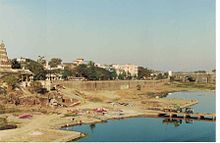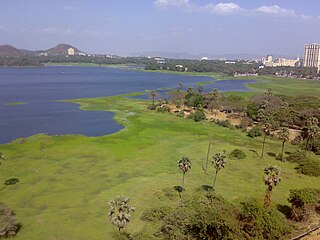
Powai Lake is an artificial lake, situated in Mumbai, in the Powai valley, where a Powai village with a cluster of huts existed. The city suburb called Powai shares its name with the lake. Indian Institute of Technology Bombay, one of the premier institutions of science and technology in India, is located to the east of the lake. Another famous institution, the National Institute of Industrial Engineering (NITIE), is also located close to the lake. Housing complexes and plush hotels are developed all around the lake periphery. Population around the lake has thus substantially increased over the years.
The Maharashtra Pollution Control Board implements a range of environmental legislation in the state of Maharashtra, India. The MPCB functions under the administrative control of Environment Department of the Government of Maharashtra.

Khadakwasla Dam is a dam on the Mutha River 21 km (13 mi) from the centre of the city of Pune in Maharashtra, India. The dam created a reservoir known as Khadakwasla Lake which is the main source of water for Pune and its suburbs.

The Bhima River is a major river in Western India and South India. It flows southeast for 861 kilometres (535 mi) through Maharashtra, Karnataka, and Telangana states, before entering the Krishna River. After the first sixty-five kilometers in a narrow valley through rugged terrain, the banks open up and form a fertile agricultural area which is densely populated.

Panshet Dam, also called Tanajisagar Dam, is a dam on the Ambi river, a tributary of the Mutha River, about 50 km (31 mi) southwest of the city of Pune in western India.The dam was constructed in late 1950s for irrigation and, along with three other dams nearby, Varasgaon, Temghar and Khadakwasla, it supplies drinking water to Pune.

The Mula is a river in Pune, India. It is dammed near the Western Ghats at the Mulshi Dam that forms the Mulshi Lake. Further downstream, in Pune city, it merges with the Pawana River on the left bank and Mutha River on the right bank to form the Mula-Mutha river, which later meets the Bhima River.

The Godavari River has its catchment area in seven states of India: Maharashtra, Telangana, Chhattisgarh, Madhya Pradesh, Andhra Pradesh, Karnataka and Odisha. The number of dams constructed in Godavari basin is the highest among all the river basins in India. Nearly 350 major and medium dams and barrages had been constructed in the river basin by the year 2012.
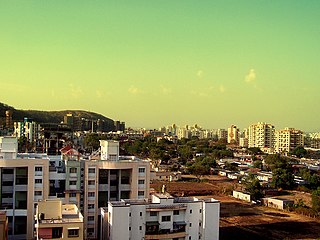
Pashan is suburb of Pune, India. It is located off the Mumbai-Bangalore national highway, by-passing Pune city. Pashan road serves as the main approach road for Mumbai-Pune expressway. Pashan is bordered by Baner in north, Sus on west, Bavdhan in south and Pune University in east. Pashan is mostly a residential suburb of Pune and large portions are occupied by various governmental and educational institutions. In October 2019, Pashan received more rainfall than the wettest place on Earth.

Pollution of the Ganges, the largest river in India, poses significant threats to human health and the larger environment. The river, which is severely polluted with human waste and industrial contaminants, provides water to about 40% of India's population across 11 states, serving an estimated population of 500 million people, which is more than any other river in the world.

Ujjani Dam, also known as Bhima Dam or Bhima Irrigation Project, on the Bhima River, a tributary of the Krishna River, is an earthfill cum Masonry gravity dam located near Ujjani village of Madha Taluk in Solapur district of the state of Maharashtra in India.

The Mula-Mutha is a river in India, formed by the confluence of the Mula and Mutha rivers in the city of Pune, which later meets the Bhima River, which itself later meets the Krishna River and finally emptying to the Bay of Bengal.

Pune Metro is a mass rapid transit system serving the city of Pune, India. The system comprises 3 lines with a combined length of 54.58 km (33.91 mi), of which 12 km (7.5 mi) on two lines are operational as of March 2022. The 16.59 km (10.31 mi) Purple line from PCMC Bhavan to Swargate runs on an elevated viaduct between PCMC Bhavan to Range Hills, from where it goes underground. The Aqua line runs from Vanaz to Ramwadi covering a distance of 14.66 km (9.11 mi) on an elevated viaduct. The 23.33 km (14.50 mi) elevated Line 3 will run from the Rajiv Gandhi Infotech Park in Hinjawadi via Balewadi to Civil Court. All three lines will align at the Civil Court interchange station.

The Pavana River is a notable river crossing the city of Pune, India. The river originates south of Lonavala from the Western Ghats, and flows a total of nearly 60 kilometres (37 mi) to meet Mula river in Pune City.
Bellandur Lake is located in the suburb of Bellandur in the southeast of the city of Bengaluru. It is the largest lake in the city. It is a part of Bellandur drainage system that drains the southern and the south-eastern parts of the city. The lake is a receptor from three chains of lakes upstream, and has a catchment area of about 148 square kilometres. Water from this lake flows further east to the Varthur Lake, from where it flows down the plateau and eventually into the Pinakani river basin.
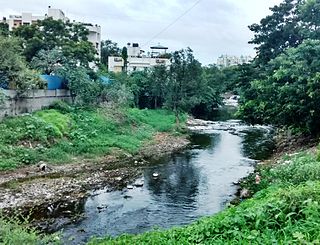
Ramnadi is a river in Pune District and is a tributary of Mula. It originates in the Sahyadris near Kathpewadi, north-west of Pune city. The river flows through the Bhugaon, Bhukum, Bavdhan, Pashan, Baner and Aundh areas of Pune city. It is defined as a brook by the Pune Municipal Corporation (PMC).

The National Green Tribunal Act, 2010 is an Act of the Parliament of India which enables the creation of a special tribunal to handle the expeditious disposal of the cases pertaining to environmental issues. It draws inspiration from India's constitutional provision of Article 21 Protection of life and personal liberty, which assures the citizens of India the right to a healthy environment.

Ghod River is located in Pune District, Maharashtra, western India. It is a tributary of the Bhima River. The Ghod originates on the eastern slopes of the Western Ghats at 1,090 metres (3,580 ft) above sea level. It flows in an east-southeast direction for approximately 200 kilometres (120 mi) before its confluence with the Bhima. It flows from the northern side of the Sahyadri Hills.
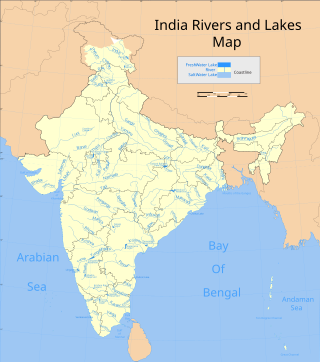
The Interstate River Water Disputes Act, 1956 is an Act of the Parliament of India enacted under Article 262 of Constitution of India on the eve of reorganization of states on linguistic basis to resolve the water disputes that would arise in the use, control and distribution of an interstate river or river valley. Article 262 of the Indian Constitution provides a role for the union government in adjudicating conflicts surrounding interstate rivers that arise among the state/regional governments. This Act further has undergone amendments subsequently and its most recent amendment took place in the year 2002.

Pashan Lake is an artificial lake near the suburb of Pashan, about 12 km from the city center of Pune, India. The lake was built in the British era to accommodate the water requirement of the neighbourhood. The main inlet of the lake is a small river (Ramnadi), which is even controlled by the barrage located to the north of the lake. The river originates from Bavdhan and flows via Pashan, Sutarwadi, Baner to Someshwarwadi before flowing into the main Mula river. Pashan lake has a total catchment area of 40 square kilometres (15 sq mi), and serves as a source of water to the old Pashan village, and the Governor's residence, as well. Recent urbanisation around the lake has led to the fall in the quality of the water.
National Green Tribunal (India) had been set up under National Green Tribunal Act as a statutory body in year 2010 to deal with environmental cases and speedy implementation of decisions relating to it. India is the third country in the world – after Australia and New Zealand – to set up such a body to deal with environmental cases.

